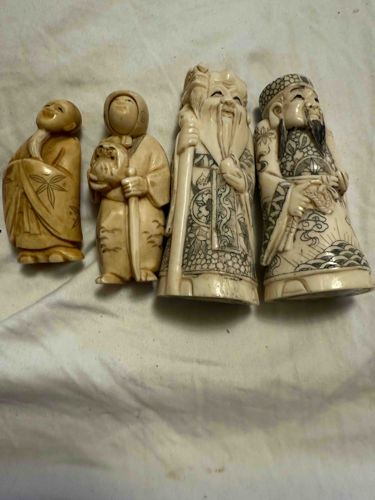
Set of Four Carved Deities/Figures
This set comprises four intricately carved ivory or bone figurines, likely depicting Chinese or East Asian deities or revered figures, possibly related to the 'Eight Immortals' or similar pantheons given their diverse appearances. Each figure exhibits a distinct personality and detailed costume. The material appears to be natural, possibly bone or antique ivory, indicated by the subtle grain and yellowish patina acquired over time. The size of the figures varies, with the tallest appearing to be approximately 3-4 inches and the smallest around 2-3 inches, though exact measurements are not possible from the image. The first figure from the left is a bald, smiling individual, possibly a monk or a representation of Hotei (Budai), with folded arms and a robe adorned with what appears to be a floral motif. Its posture suggests contentment. The second figure is hooded and holds a staff and an object resembling a small animal or fruit, rendered with delicate features. The third and fourth figures are elderly men with long beards, dressed in highly detailed robes. Their garments feature extensive incised decoration, including geometric patterns, waves, clouds, and celestial elements, highlighted with dark pigment to contrast with the light material. The quality of carving suggests skilled craftsmanship, particularly in the fine lines of the robes and the expressive faces of the figures. Observable condition issues include general surface dirt and a visible patina, consistent with age and handling. There are no obvious chips, cracks, or repairs visible. The base of the larger figures appears flat, designed for standing. The style points to an East Asian origin, likely Chinese or Japanese. Given the provided context of "Ming Dynasty," these pieces might be exceptionally old if genuine, and handcrafted from bone or pre-ban ivory. The detailing and characterization indicate they are not mass-produced, but rather works of a skilled artisan, potentially dating from the late Qing Dynasty to the early 20th century or earlier if truly Ming era, which would be exceedingly rare for this type of detailed carving.
AI-Generated Appraisal Disclaimer
Estimated Value
$800 - $1,500
Basic Information
Category
Figurines/Sculptures
Appraised On
December 8, 2025
Estimated Value
$800 - $1,500
Additional Details Provided By Owner
User Provided Information
ming dynasry
Item Description
This set comprises four intricately carved ivory or bone figurines, likely depicting Chinese or East Asian deities or revered figures, possibly related to the 'Eight Immortals' or similar pantheons given their diverse appearances. Each figure exhibits a distinct personality and detailed costume. The material appears to be natural, possibly bone or antique ivory, indicated by the subtle grain and yellowish patina acquired over time. The size of the figures varies, with the tallest appearing to be approximately 3-4 inches and the smallest around 2-3 inches, though exact measurements are not possible from the image. The first figure from the left is a bald, smiling individual, possibly a monk or a representation of Hotei (Budai), with folded arms and a robe adorned with what appears to be a floral motif. Its posture suggests contentment. The second figure is hooded and holds a staff and an object resembling a small animal or fruit, rendered with delicate features. The third and fourth figures are elderly men with long beards, dressed in highly detailed robes. Their garments feature extensive incised decoration, including geometric patterns, waves, clouds, and celestial elements, highlighted with dark pigment to contrast with the light material. The quality of carving suggests skilled craftsmanship, particularly in the fine lines of the robes and the expressive faces of the figures. Observable condition issues include general surface dirt and a visible patina, consistent with age and handling. There are no obvious chips, cracks, or repairs visible. The base of the larger figures appears flat, designed for standing. The style points to an East Asian origin, likely Chinese or Japanese. Given the provided context of "Ming Dynasty," these pieces might be exceptionally old if genuine, and handcrafted from bone or pre-ban ivory. The detailing and characterization indicate they are not mass-produced, but rather works of a skilled artisan, potentially dating from the late Qing Dynasty to the early 20th century or earlier if truly Ming era, which would be exceedingly rare for this type of detailed carving.
Get Your Items Appraised
Instant estimates of your treasures with AI-powered instant appraisals